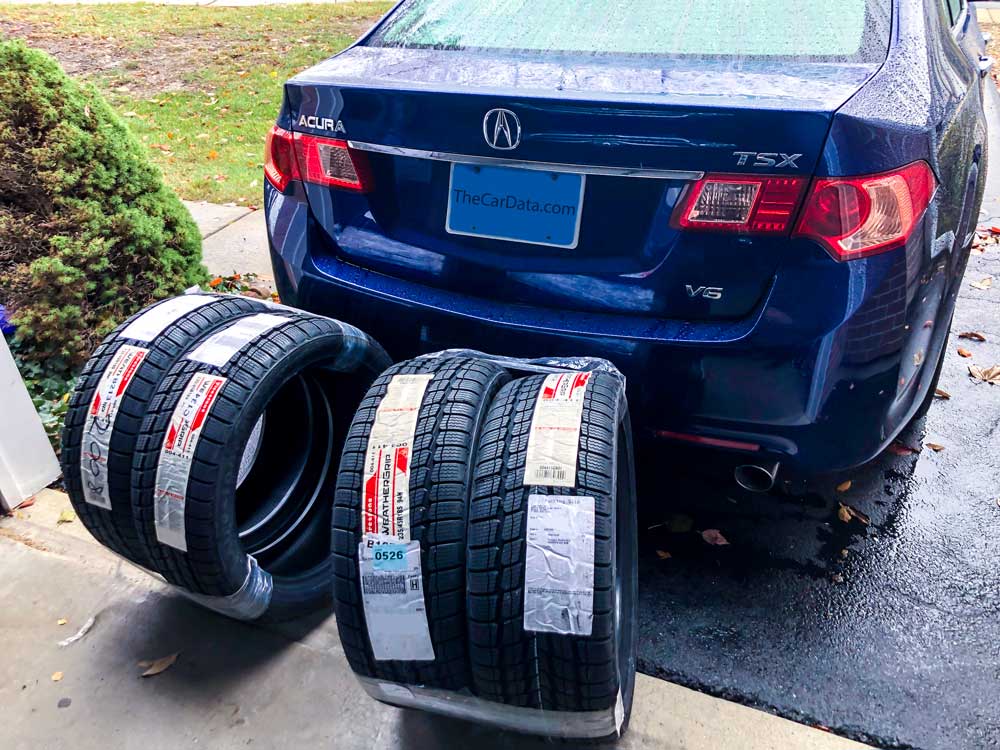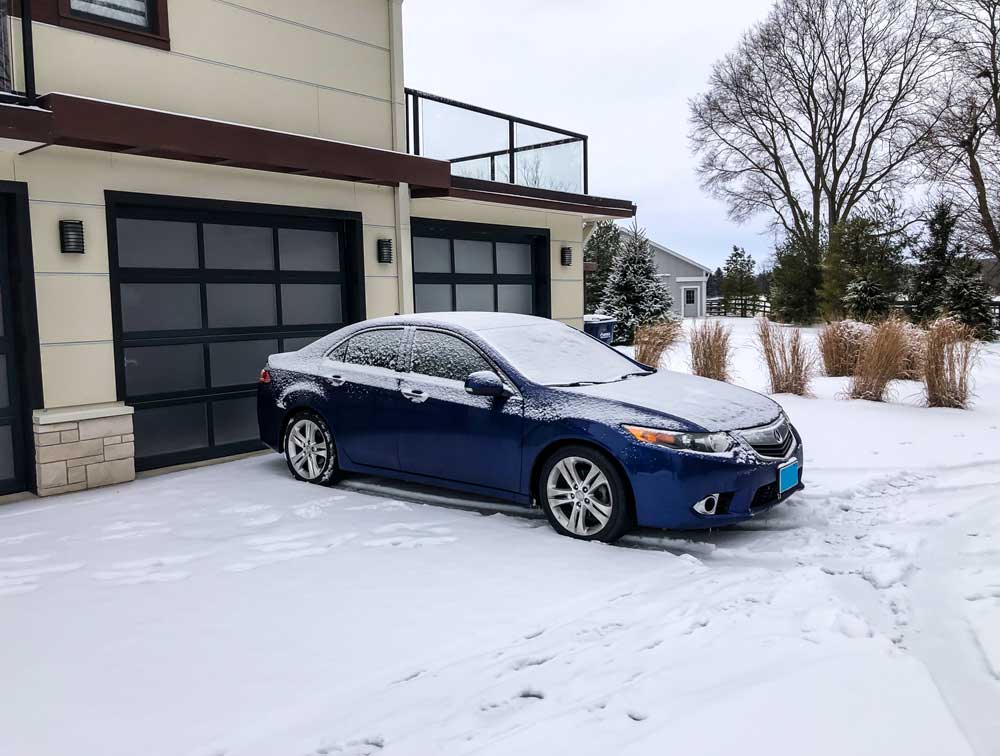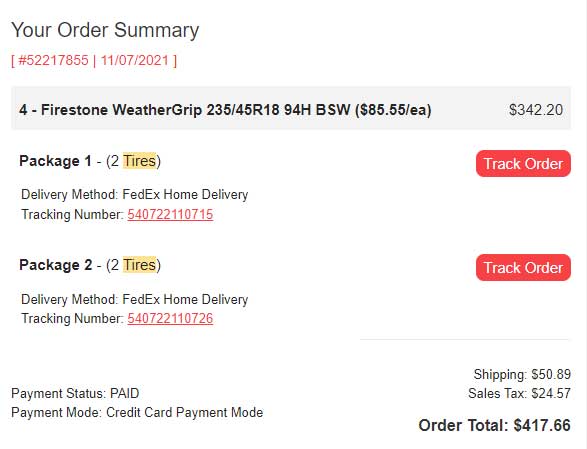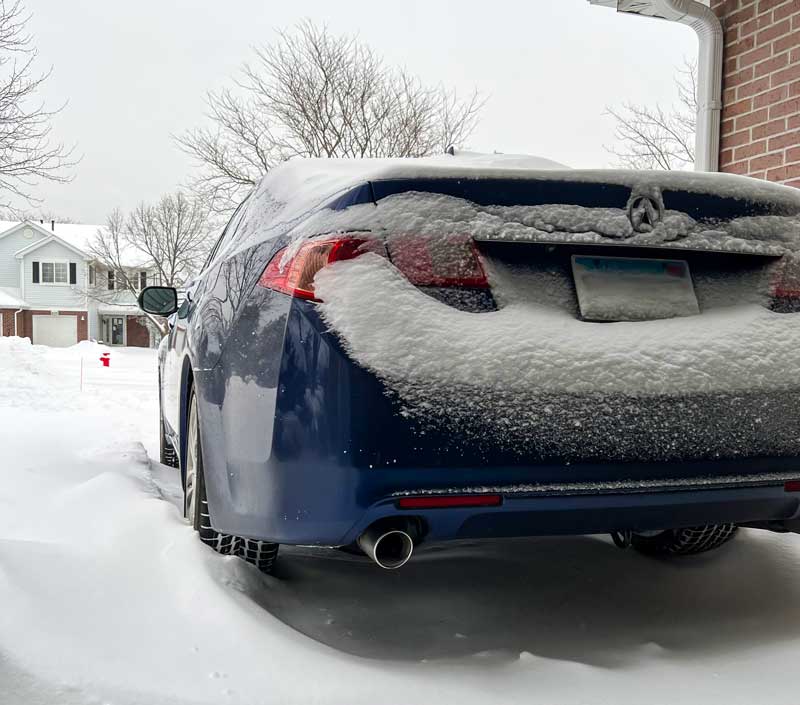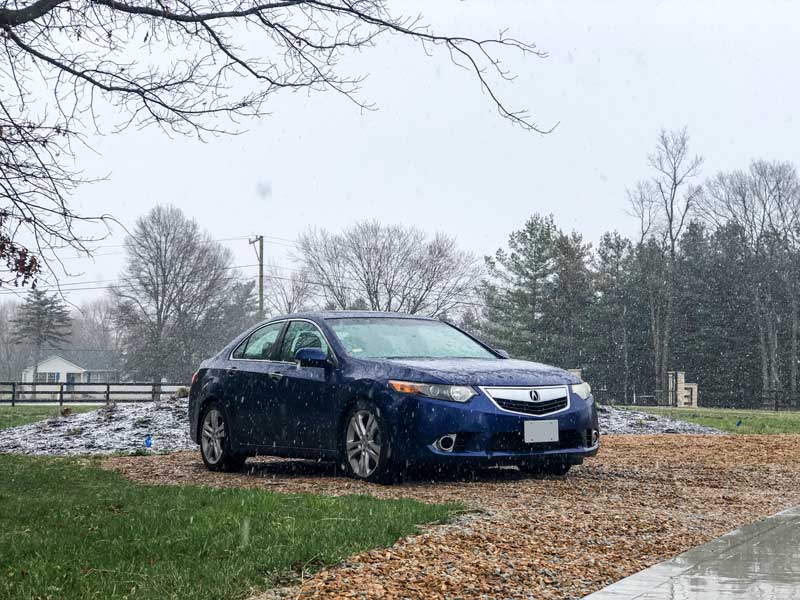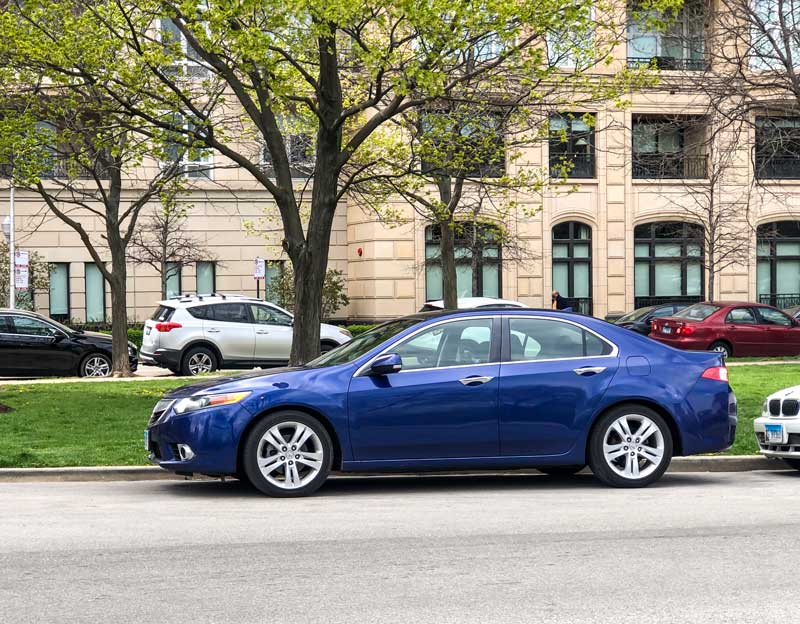Firestone WeatherGrip Review: How Good is This All-Season Tire?
Some of the links on this page may link to our affiliates. Learn more about our affiliate policies.
Last Updated: August 30, 2023
Brand: Firestone
Model: WeatherGrip
Warranty: 5 Year/65,000 miles
Price: $127.00 - $234.00 per tire
Load Range: SL - XL
Features: Touring, All Season, Three-Peak Mountain Snowflake, Performance
Weight: 17 - 35 Lbs
Load Index: 82 - 106
Speed Rating: H - Up to 130mph - V - Up to 149mph
Max PSI: 44 - 51 PSI
Rating: 4.8/5.0 ⭐⭐⭐⭐⭐
Firestone WeatherGrip tire is a popular choice among drivers who want a tire that can handle various weather conditions and road surfaces. Regarding getting tires for my 2011 Acura TSX, I purchased Firestone WeatherGrip tires because of the reputation and price point. Besides tires noise, in my opinion, these tires are extremely good for someone that loves to get quality on a budget.
The WeatherGrip tire is designed with advanced technology that provides superior traction and handling, no matter the weather. Its asymmetrical tread pattern and all-season compound help to reduce the risk of hydroplaning and maintain a grip on wet and slippery roads. In addition, the tire's circumferential grooves and lateral notches help to evacuate water and improve wet and dry traction.
Overall, the Firestone WeatherGrip tire is a reliable and safe choice for drivers who want a high-performance tire that can handle various weather conditions. In this review, we'll take a closer look at the features and benefits of the WeatherGrip tire and see how it stacks up against the competition.
Testing Conditions, Equipment, Results
Test Location: Illinois, Indiana, Michigan
Vehicle: 2011 Acura TSX V6 (front-wheel drive)
Tire Size: 235/45 R18
Terrain: Heavy snow, thick ice, heavy rain, light off-road with snow
Driver experience: Expert, CDL Holder, close to 2M miles driven with a lot of experience driving various types of vehicles in snow
Firestone WeatherGrip Testing Results
Heavy Snow Rating: 4.2/5.0
Light Snow Rating: 4.9/5.0
Ice Rating: 4.0/5.0
Wet Traction Rating: 4.7/5.0
Dry Traction Rating: 5.0/5.0
Uneven Pavement Rating: 4.1/5.0
Noise: 3.0/5.0
Overall Rating: 4.27/5.0
Outstanding Features
Firestone WeatherGrip is an all-season, grand-touring tire that can be fitted to most passenger cars. It's suitable for sedans, hatchbacks, coupes, minivans, and crossovers. There are many sizes available, from 15-inch up to 19-inch wheels. If you have a passenger car manufactured in the past two decades, you should find one that fits.
Firestone used the industry-standard tread wear indicator (TWIs) like most other manufacturers. These indicators are required by law because they indicate when your tires must be changed. TWIs are narrow rubber strips that protrude from the surface at 2/32 inches. They sit in the grooves of the tires. They will flush with the surface when the tread depth is 2.22 inches.
Authorities chose 2/32 inches as the minimum tread depth because it is believed that tires with less tread will not provide hydroplaning resistance. They won't be safe to drive in wet conditions. But what about snow or ice? This is a great question, and it's important for Firestone WeatherGrip. Tires with a width of 2/32 inches will work well under rainy conditions for safe traction and grip. However, tires with this tread depth will only work in the snow.
Firestone has not equipped the WeatherGrip with such indicators. However, other tire manufacturers don't offer them (on all-season tires). The Firestone WeatherGrip has a 65,000-mile treadwear guarantee. This is slightly less than some of the most expensive grand-touring all-season tires but still a great deal for an all-weather tire with winter credentials.
The Michelin CrossClimate 2 is more expensive, with a 60,000-mile treadwear warranty.
Pros
- Snow handling is very safe and easy to control when it loses its traction
- All-season tire with exceptional acceleration on snow-packed and unpacked
- Performed very well on icy roads for all-season tire
- Good grip on dry roads, especially with a tire with so many sipes and grooves.
- You get the best deals on most bumps without any fuss
- Long treadwear warranty and tread life that is very solid
- Great price, especially if you can find a deal for them
Cons
- The more aggressive tread pattern makes them noisier than other all-season tires
- Extremely slight vibration paired with road noise could get slightly annoying to some people
Testing of Firestone WeatherGrip Tires
All-season tires are a favorite of North American drivers. So it's understandable why all-season tires are so popular in North America. They are affordable, offer safe year-round traction, and last longer than any other type. The Firestone WeatherGrip tire is designed to provide superior traction in weather conditions, including snow.
Its asymmetrical tread pattern and all-season compound help to reduce the risk of hydroplaning and maintain a grip on wet and slippery roads. In addition, the tire's circumferential grooves and lateral notches help to evacuate water and improve wet and dry traction.
The WeatherGrip tire also features a directional tread design optimized for snow traction. Its directional tread pattern helps to improve grip on snow-covered roads, particularly when driving in a straight line or longitudinal direction. In addition, the tire's directional tread blocks and 3D zigzag sipes work together to provide enhanced bite and traction on snow-covered roads.
Overall, the Firestone WeatherGrip tire is a reliable choice for drivers who need a high-performance tire that can handle various weather conditions, including snow. Its directional tread design and advanced tread compound help to provide superior traction and handling on snowy roads, making it a great choice for drivers who live in areas with frequent snowfall.
The tire also comes with the 3PMSF symbol (Three Peak Mountain Snowflake), which indicates higher-than-regular longitudinal snow traction. This can be seen in the aggressive tread pattern with a greater void area and multiple sipes across each block. It is more winter-like than an all-season tire in this sense.
Purchasing Process - Where to Buy Firestone WeatherGrip Tires
As you see from the screenshot below, I got a REALLY GOOD DEAL on these tires. I purchased them through the Giga-Tires website; however, I was never able to find the same or a similar deal again. This deal spotting took me about a month of closely monitoring Google and various other platforms where I was tracking prices.
My total cost for these tires went as follows:
- 4 Firestone WeatherGrip Tires: $417.66
- Installation of the tires @ $20 each at a local tire shop: $80
- Total: $417.66
Testing in Heavy Snow
The vehicle that I put these tires on is very torque-happy. Acura TSX V6 tends to break traction if gassed slowly. And that's what it used to do with All-Season Continental tires on dry pavement with 90%+ of the thread-life left. So the fact that Firestone WeatherGrip helped the initial movement of this Acura not to become a circus show was a huge relief to me. Before putting the WeatherGrips on, I would not have dared to hit the streets with more than 2" of snow on the ground.
With WeatherGrips on the car, I was not afraid to take on the snow. As a matter of fact, it was fun to do so. The car did very well accelerating in snow and changing lanes while crossing snow banks that built up. However, the stopping was a worry, but it was hard to tell if it was because of Acura's traction control system underperforming or the tires. The final verdict on snow performance is that the Firestone WeatherGrip All-Season tires did extremely well.
Testing in Snowy and Icy Conditions
After my trip through Indiana, I have to give Firestone WeatherGrip tires a lot of respect. Winter driving is where WeatherGrip claims it offers the greatest improvement over all-season and all-weather tires. Firestone used its Snow Traction Claw technology to add traction in the snow on the shoulder ribs and center. As a result, I was able to maintain great traction on the road, and while other drivers had a tough time keeping their vehicles on the road, I had no issues, nor did I have any close calls while going 30-50 mph.
To improve the snow traction, engineers from the brand also created snow vices and high-density zigzag sipes. In addition, the TractionTech Package adds additional edges to the tire, which helps it retain its snow, ice traction, and life span.
The tread pattern is designed to channel water away from the tire's contact patch. This helps to reduce the risk of hydroplaning, which occurs when a tire loses contact with the road due to a layer of water between the tire and the road surface. In addition, by channeling water away from the contact patch, the tread pattern helps maintain contact between the tire and the road, improving traction and stability.
Overall, Firestone WeatherGrip tires are a good choice for driving in wet and slippery road conditions, as they are designed to provide improved traction and stability. By following proper tire maintenance and driving techniques, you can maximize the performance of these tires and stay safe on the road.
Wet Traction Test
Firestone used its Hydro-Grip Technology package. This uses a rounded footprint to cut through standing water. It also features full-depth grooves that drain water from the tread. This results in outstanding hydroplaning resistance - your car will not lose stability even if you drive through deep water puddles.
Rain traction doesn't have to be about hydroplaning resistance. The tread compound must also do a good job sticking to wet pavement. In this instance, the WeatherGrip performed admirably in our wet road testing; the longitudinal traction was good, and the tire felt confident when cornering.
It has some issues with braking, as its stopping distances are longer that those of its main competitors. Most premium all-season tires perform better in rainy conditions than the WeatherGrip and some all-weather tires like the General Altimax 365 AW. However, I find the traction and grip adequate for daily driving in wet conditions.
Dry Asphalt Testing
The tire has an aggressive tread pattern and an all-season rubber compound. It also features large sipes and deep grooves.
Let's look at each feature to see if they make a difference in real life. Dry Grip and TractionWeatherGrip's directional tread pattern is focused on providing the best longitudinal traction.
Firestone added chamfered shoulder block to the tire, designed to increase cornering grip on wet roads and enhance braking.
But did it work? The WeatherGrip certainly isn't a slouch when it comes to dry roads. My dry road test shows that the longitudinal traction it provides is effective. This means your vehicle will accelerate quickly and stop in a short time.
The tire's cornering grip impressed me, even though it wasn't made with this in mind. But, of course, any tire with so many sipes will have trouble with cornering. I also took into consideration the WeatherGrip in the context of grand-touring all-season tires.
The Bridgestone Turanza QuietTrack will offer better grip and traction than the competitor.
The Michelin cross climate 2 is a better choice, offering greater grip and traction. The WeatherGrip is still good enough to drive daily. It is still superior to all-weather tires on dry roads and has sufficient grip and traction to drive safely at legal speeds. Winter tires are notoriously difficult to respond to steering and feel. This is due to the softer and more flexible compound and the smaller contact area with the road.
The WeatherGrip is a winter tire with a tread pattern. As a result, it doesn't respond to driver inputs very quickly, and the steering feels sluggish. In addition, it could be better because the tire can't go straight from turning to going straight. Straight-line tracking is an excellent feature that is the most important for passenger car drivers.
Road Noise and Comfort
Firestone claims it was focused on providing a comfortable ride using the WeatherGrip. However, since my opinion of a comfortable ride consists of low tire noise, I wonder if I would agree with the claim by the company. I found WeatherGrip tires noisier than the All-Season tires I have tested before. However, I would choose safety if I had to choose low noise levels or the safety that comes with WeatherGrip.
As fire as driving comfort (that does not include noise), the tire can travel smoothly on most roads and doesn't emit vibrations or harshness within the cabin. However, there is a slight shiver when you hit larger potholes, and the drive felt a lot sportier than it should have been, considering that this is not a performance tire and the car is not a performance car.
On the other hand, at high speeds, the tires felt solid and stable, the noise of the tires decreased, and the car felt like it was on rails.
Who Should Purchase Firestone WeatherGrip Tires?
Although the Firestone WeatherGrip may not be a perfect tire, it is a good option. Firestone has sacrificed some dry and wet treads to improve performance on snow. However, this tire is not recommended for people who live in harsh winter conditions where roads are seldom cleaned or salted.
A WeatherGrip tire is a great option for snowy or icy roads. The WeatherGrip provides dry and safe traction for everyday driving while bringing snow and ice traction closer to winter tires. However, if your area gets slammed with heavy snow, consider getting Bridgestone Blizzak WS90 tires or similar. Fun fact: Bridgestone owns Firestone.
The Car Data Tire Testing Methodology
We take pride in providing thorough and unbiased reviews of the latest tire models. To ensure that our ratings are accurate and consistent, we have developed a rating methodology that considers various factors and incorporates statistical analysis.
- Performance: We test tires for their performance in various driving conditions, including wet and dry roads, snow and ice, and off-road terrain. We also consider factors such as handling, braking, noise, and ride comfort. These tests are conducted using standardized procedures, and the results are analyzed using statistical methods to determine the mean and standard deviation.
- Durability: We assess the durability of tires based on factors such as tread life, resistance to punctures and cuts, and sidewall strength. These tests are conducted using standardized procedures, or data gathered from third-party websites where real users share their experiences with the products that we are reviewing. We then analyze the results using statistical methods to determine the mean and standard deviation.
- Value: We consider the price of the tire and compare it to its performance and durability to determine its overall value. We pay close attention to how long the tires last, reported life-span of the tires, as well as the ratio of those metrics when compared to the price.
- Customer reviews: We consider the experiences and opinions of other drivers who have used the tire. We do our best to disregard what seems to be fake reviews (good or bad), and make judgement calls based on our ability to filter bogus reviews well. We are human, therefore mistakes can be made. The best reviews that we provide are always the ones where we get to extensively test the products ourselves and share real-life experiences with our readers.
- Expert opinions: We consult industry experts and gather their insights and opinions on the tire. An expert can even consists of a person that has extensive knowledge through the use of the tires and has practical experience with them.
Our ratings are based on a scale of 1 to 5, with one being the lowest and five being the highest. We strive to provide detailed and comprehensive reviews that give drivers the information they need to make informed purchasing decisions. Overall, this methodology, which incorporates statistical analysis, allows us to provide accurate and reliable ratings for the tires we review on our site.
Firestone WeatherGrip Tire Review - Bottom Line
In conclusion, the Firestone WeatherGrip tire is a reliable and high-performing one that is suitable for various weather conditions. Its asymmetrical tread pattern, all-season compound, and directional tread design provide superior traction and handling on wet and snowy roads, making it a safe and reliable driver choice.
Additionally, the WeatherGrip tire is known for its durability and long tread life. Its tread compound is formulated to resist tread wear, helping the tire to maintain its performance and grip over time. This means that drivers can expect good value for their money with the WeatherGrip tire, as it can last for many miles before needing to be replaced. Would I purchase Firestone WeatherGrip tires again despite them being noisy? Yes, absolutely. In my humble opinion, there aren't many All-Season tires that can beat the price to value ratio of these tires.

Steven Dillon
Author
Steven is the founder and product tested for The Car Data, that has extensive knowledge in automotive industry. While most of his free time he participates in typical "car guy" activities, his passion for cars, data analytics, and tech, always has his looking for the next cool tool, software, trend, etc. to share with his audience on The Car Data or on his Instagram.

© 2023 The Car Data. All rights reserved.
